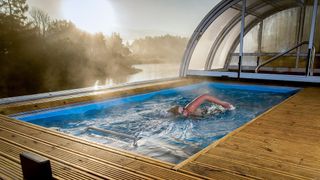Much like having a hot tub (opens in new tab) installed, a swim spa offers you an at-home alternative to the club or spa, but unlike a jacuzzi, these machines are designed to offer you an exercise solution at home. If you’ve ever considered having a swimming pool installed, you’ll probably have considered the maintenance costs. Heating a swimming pool year-round is costly, even with the best pool heaters (opens in new tab) you can buy, but swim spas have all the smart tech to monitor and adjust the heating of your pool automatically. This is great news, because there’s nothing worse than dipping your toe into the pool, only to realize it’s icy cold. Especially if you suffer from joint pain or arthritis, a swim spa is a great way of keeping your body warm and your blood pumping as you exercise, and the heat can also reduce pain and inflammation. Swim spas are typically best heated to around 80 degrees Fahrenheit, but this can be raised to over 100 degrees if you want the heat of a hot tub but with a lot more space. Some spas even come with separate hot tub and swim spa areas, which use the same high-power jet technology but can be heated independently.
How much does it cost to heat a hot tub?
According to Bona Vista, the cost of heating a swim spa is the equivalent of the cost of a cup of coffee every day. While that’s not so expensive, it can add up over the months. The cost of heating your swim spa depends on the volume of water inside it, and how hot the water is compared to how hot you want it to be. You can cut the cost of your swim spa maintenance by setting the temperature a few degrees lower. Because you can program your swim spa to maintain a set temperature, this will keep it from having to work too hard when you’re in the hot tub and it’s giving off the most heat. The speed at which your swim spa loses heat is another factor to consider. If you live in a warm climate, your swim spa will retain heat far more easily than cooler climates. One way to lock the warmth into your spa is by using a swim spa cover that traps in heat like a blanket on a cold night. You should also check out which swim spa companies are most energy efficient, because some have a higher quality of insulation lining their tubs than others.
Should you always keep your swim spa heated?
There are ways to heat your swim spa more efficiently so as to cut back your energy costs, and one of the best ways to do this is to keep it heated. Letting the water turn cold after use, only to heat again in a few days, takes a lot more time and energy than simply maintaining the temperature of your hot tub. Turning the temperature down for a few weeks away is better than turning your spa off completely, according to Hydropool. If you do plan on leaving your swim spa unused for a few weeks or months, you can also check out our guide on how to winterize a hot tub. While this isn’t specifically swim-spa guidance, the steps and principles are the same. If you leave your swim spa unheated and unused over the colder months, it can damage the inner workings due to the risk of freezing. Draining your swim spa also gives you the chance to give it a deep clean, which will be good for the jets and filters. For more water-based fun and relaxation, also take a look at our guide to the best inflatable hot tubs (opens in new tab).
